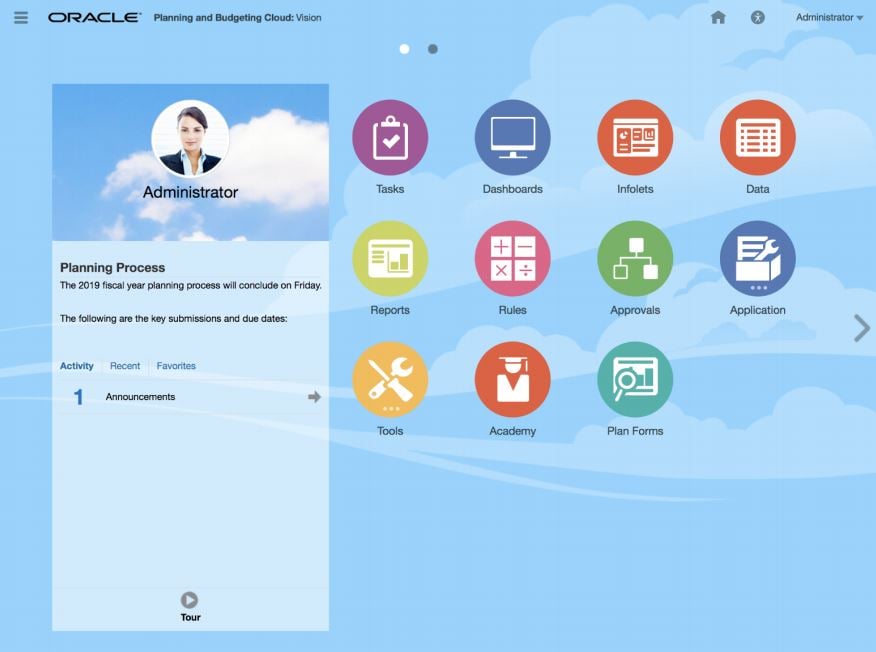New features and updates for Oracle's Account Reconciliation Cloud Service (ARCS) have finally arrived! In this blog post, we’ll outline new features coming to ARCS in May, including loading journal entries, as well as viewing audit reports and period history.
We’ll let you know any time there are updates to ARCS or any other Oracle EPM cloud products. Check the US-Analytics Oracle EPM & BI Blog every month.
The monthly update for Oracle ARCS will occur on Friday, May 17 during your normal daily maintenance window.
ARCS New Features
Importing & Exporting Teams and Users
System Administrators and Power Users can now perform a bulk update of teams and members, rather than having to update teams and members individually. You need to create an export a comma separated value (csv) file, and when you are ready, you can import the information back to the application.
Increased Number of Attribute Columns
Data Management and Account Reconciliation have increased the number of Attribute columns to which you can import values to 40. Each attribute column can now accept up to 300 characters.
Exporting and Importing of Match Types Across Environments
System Administrators can now export the configuration of a Match Type, and then import it using one of the following options:
- Import back into the same environment with a different Match Type name
- Import to another ARCS environment.
Updated Academy
The Academy has been updated to reflect recent changes in the software user interface and functionality as well as current videos.
New Status Column on Unmatched Transactions
A Status column has been added to the Unmatched Transactions screen to indicate the current status for each unmatched transaction: New or Supported. You can also select both options through the Filter to select All. if you select All for the status, both the New and Supported icons display for that transaction. There is no separate All icon.
Viewing Audit Report
Previously, only Periods could be viewed on a report. With this release, in addition to Periods, a new auditing dashboard is available. This Audit Report enables you to see any changes made to the service for the following objects:
- Attribute
- Filter
- Format
- List
- Organizational
- Unit
- Period
- Profile
- Reconciliation
- Setting
- Team
Amortization Requires a Zero Ending Balance
The Ending Amount for amortizing transactions must result in a 0.00 balance; otherwise, an error is displayed. You must manually correct the transaction to render a zero ending balance. Existing non-zero balances will be preserved, but if you edit the transaction, you will need to zero them before the changes can be saved.
Loading Exported Journal Entries from ARCS
Data Management can now be used to load exported journal entries created in ARCS to a Transaction Matching target application.
Viewing Period History
You can view a history of all actions performed on a Period, including the dates, and the old and new values.
New Version of the EPM Automate Utility
A new version of the EPM Automate Utility is available with this update. This version includes support for Mac OS and the ability to run multiple sessions of the utility from the same directory. This version also includes new commands ( ApplicationAdminMode and SortMember) and updates to the replay command to support Lagtime parameter and to the ProvisionReport command, which now, by default, generates the simplified version of the Provisioning report instead of the classic version. You must install this version of the utility to use these enhancements.
- Support for Mac OS: The EPM Automate Utility can now be installed on Mas OS computers.
- Ability to run multiple instances of the utility from the same directory:
The EPM Automate utility now supports the execution of multiple instances of the utility against an environment from the same directory. You can now...- Run multiple instances of the utility from the same directory
- Execute the utility from separate directories
In both these scenarios, each instance of the utility works independently; logging out of one instance does not log you out of other instances.
- New ApplicationAdminMode command
This command places the application in administration mode so that access to the application is limited to Service Administrators only. This command is useful to prevent users from working on the application when Service Administrators are performing administrative operations. - New sortMember command
This command sorts members of Entity, Account, Scenario, and Versions dimensions and of custom dimensions. This command is useful for sorting dimension members after loading members into Planning. - New lagTime parameter for replay command
lagTime, an optional parameter, allows you to set the number of seconds that the replay command should wait between the execution of each HAR file included in the replay file. Because user activities are not usually initiated simultaneously, setting this parameter helps to create a more realistic simulation of load on an environment. - The provisionReport command now produces a simplified version of the report by default
The provisionreport command now, by default, generates the simplified version of the Provisioning Report identical to the report that is displayed on the Provisioning Report tab of the Access Control screen. You can generate the classic version of the report, which lists the component roles that are subsumed into the pre-defined roles to which users are assigned and the application roles assigned to the user (directly or through groups), by using the format=classic parameter.
Removal of Support for Transport Layer Security Protocol 1.0 and 1.1
As announced in previous readiness documents, starting with this update (Release 19.05) to EPM Services, Oracle will support only Transport Layer Security protocol version 1.2 (TLS 1.2) to communicate with EPM Cloud. To ensure the highest level of authentication and data encryption security, TLS 1.0 and TLS 1.1 will no longer be supported after your environments are updated on May 3, 2019.
Note: Support for TLS versions 1.0 and 1.1 will be removed for both your Test and Production environments on May 3, 2019.
Because most modern operating systems and browsers support TLS 1.2; users of such systems and browsers will not be affected by the deprecation of TLS 1.0 and 1.1. EPM Automate and Smart View are also not affected by this change.
After TLS 1.1 is deprecated, you cannot use client operating systems that do not support TLS 1.2 (for example, Red Hat Enterprise Linux 5 and Microsoft Windows 2002) to run operating system-specific commands (for example, code to run cURL tools to transfer data and custom code that integrates with the Rest APIs) against EPM Cloud. Additionally, Smart View installed on such systems will also fail to communicate with EPM Cloud. Similarly, you cannot use browsers that do not support TLS 1.2 protocol to access EPM Cloud environments
Upcoming Changes
EPM Cloud's New Look and Feel
In a future update, there will be a revised interface with enhanced navigation and a new theme called Sky Blue.

The revised interface retains existing functionality and enhances your Home page experience with a more responsive design. The Welcome panel and the global header readjust after resizing, which means less scrolling. Clearer announcements and notification areas are added to the Welcome panel, as are arrows to help you navigate easily between the Home page and your infolets. A bigger Navigator menu has improved usability, more themes for customization are included, and a bigger work area has more space to maneuver and provide better visibility. The interface is more consistent with other Oracle products, such as Fusion Applications.
After the interface is released, all new customers will use the new lighter-colored Sky Blue theme, and existing customers will keep their current theme. You can switch themes using Tools, and then Appearance.
Considerations
Academy
In the Academy, some pages and icons may appear different in the video and the Cloud service.
Using Refresh
It is a best practice to use Refresh within the Account Reconciliation Cloud user interface rather than performing a browser refresh.






